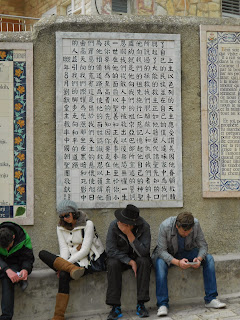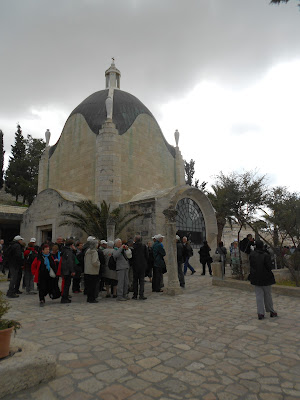 |
| entrance to "the Dungeon" |
Dara was hot! Exposed as it is on the plain of
Mesopotamia it affords little shelter from the sun. Earlier in the year at the height of summer I suspect the heat was gruesome. But I would not have missed this for the world.
Not least of our experiences were our visits to two cafes near the ruins, very different from each other but both offering traditional and authentic Turkish hospitality, at which these friendly people are so good. But I'm getting ahead of myself.
 |
| Down in "the Dungeon" |
We had come to learn more about the culture and history of this fascinating region so the ruins had to come first. The dearth of information available on the internet about
Dara does little justice to the importance of this East Roman strong fortress city in northern
Mesopotamia on the border with the Sassanid Empire. True it is quite close to the Syrian border and the present conflict will surely put off potential visitors to this area. But we experienced nothing but friendliness as we strolled through the village and around the ruins themselves.
This is the site of a significant Roman fortress used in the conflicts with the Persians in the 6th century. There has been a large amount of archaeological excavation work at the site since 1986, which now seems to be shelved perhaps just for the time being.
 |
| another water cistern |
 |
| ruins of Dara - bridge can be seen in background |
The first place we went was “the dungeon”, deep below ground level, entered through a small and insignificant looking doorway. This was an incredible feat of the engineers of Justinian: they diverted the river Cordes and constructed this underground water cistern of huge proportions. The brave among us climbed down the very steep and uneven stone steps to the very bottom of this cavernous place, only to be suddenly plunged into utter and total darkness as the lights failed! Fortunately someone had a torch but the lights soon came on again. This was one of three water systems which we saw, the one nearest to the necropolis probably constructed to supply the city with its water. It has also been suggested that this area was first a stone quarry in the Roman era.
 |
| our tour guides at Dara! |
There are detailed information boards at the entrance to the necropolis site (from the Ancient Greek meaning “city of the dead”), which give quite a bit of background detail, although the translation to English from the Turkish sometimes requires a little guesswork in its interpretation. But broadly here is pretty much what they tell us:
Dara was founded during the reign of the Byzantine Emperor Anastasius 491-518 (deduced it seems by the existence of an inscription in the “building with the mosaic floor”, sadly missed by our group, that proclaims
Anastasiapolis to be the original name of the city, thus establishing its founder - others say the city was built by the Persian King Darius - it seems that even historians cannot agree on this.). One of the largest citadels on the borders with Persia, the board tells us it was founded by the Byzantine empire although later altered during the Justinian reign. Excavations have unearthed ruins of the Roman period, which show that Dara was the scene of many wars in the late Roman- early Byzantine period. There is much excavating still to do.
The city wall, the information board continues, is 4 km long, and 3 m thick, supported by bastions, and much of this wall is still standing and clearly visible. Further away from the city, we are told there are some deep ditches, thought to be dug as defence against more sophisticated wheeled vehicle attack.
We are able to see the ruins of the great city entrance, with the now dried up bed of the Dara stream, and the main street with the agora or meeting place (this would have been the center of the athletic, artistic, spiritual and political life of the city).
 |
| A Cross at the Necropolis |
 |
| an authentic Turkish Hubble Bubble cafe at Dara |
The
necropolis is to the west of the city and dates back to 600 AD. It is astonishing. Carved out of the bedrock, it has engraved galleries and tombs, some multi-storeyed, along with
sarcophogai, with and without lids. These are said to have been used at different times by different cultures, including the Syriacs and the Sassanids.

Part of this complex is thought to be the site where the dry bones came to life in the story from
Ezekial ch. 37 vv 1-14 (also mentioned in one of the Qu’ran Surahs). There is evidence of the ruins of churches within the
necropolis, perhaps carved from the larger tombs when Christianity came to
Dara. (These I believe were pointed out to us by the children, but we could understand little from their minimal grasp of English, although they were very keen to show us everything they could about the site).
 |
| anyone for Ayran? |
 |
| Refreshing Ayron with mint |
 |
| some opted for coffee! |
As we strolled around the extensive ruins of the city, up the main street, onto the dried up river bed where the remains of a bridge was clearly visible, and along parts of the old wall, we were accompanied by the most beguiling children, eager to make friends with us and to act as our guides. In particular the necropolis seemed to capture their imagination and they tried hard to communicate to us the most important features that we clearly should not miss.
Sadly I had no small change to reward them for their efforts, not even any sweets. They had honestly earned some reward. I only hope that they fared better from the coach load of tourists who were arriving as we left. At least we helped the local economy by buying many drinks for our thirsty group in the two cafes that we found close to the sites. Perhaps the proprietors were in some way related to our child guides. I suspect so, even if only indirectly. I like to think so.






































